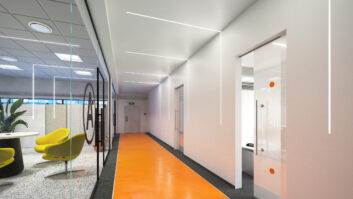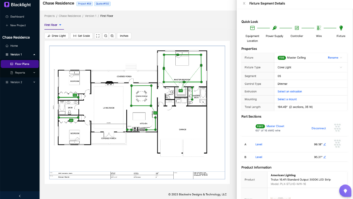The next significant residential lighting design trend is an innovative combination of technology and ecology, providing great visual impact and giving designers more ecologically correct, longer lasting options than ever before. New developments for the residential marketplace in LED (light emitting diode) and fiber optic technologies combined with the use of solar power present creative, versatile and energy efficient design opportunities. These options should pique the interests of designers, dealers and installer, because they can be incorporated into innovative signature designs and increase revenue.
As even more advances are made, products will continue to become more robust, reduced in size, use less energy and be more cost effective, offering a dynamic potential to achieve general ecological well being in the world of lighting.
LED technology currently represents the most efficient source of lighting available today. It is purported to have a 100,000-hour lamp life depending on the color (still in testing). That’s 100-times longer than the standard incandescent lamp, equating to 11.4 years. The digital lighting technology, LED contains a chemical compound that emits light when an electric current passes through it. Using microprocessor-controlled red, green and blue LEDs, the Color Kinetics Chromacore product (www.colorkinetics.com) can produce 16.7 million colors, or what Color Kinetics refers to as “full-spectrum digital lighting.”
That’s just the beginning. LED systems are ideal for extended-operation applications, virtually eliminating the costs for replacement lamps and associated labor. LEDs use about 10 percent of the power of conventional lamps, reducing energy costs and conserving fossil fuels. They are shock and vibration resistant, with varying degrees of brightness and they are dimmable so they can be custom-tailored to fit specific requirements. LEDs are silent when in operation so they lend themselves very well to theater applications. An LED generates no heat or UV, so they can also be used in “contact” situations and for UV sensitive materials such as fabrics, artwork or tapestries. Many LED systems are completely programmable with controllers provided by the system manufacturer or alternatively controlled by a PC or DMX controller.
The use of light incorporated into a dynamically changing scene engages a viewer (or potential customer), and can truly be used as a mood-altering tool. A full spectrum of color, brightness control, dimming and programmability provide a creative designer or installer an entire new realm of possibilities with lighting effects. LEDs can be used for accent lighting, cove lighting, active color displays, holiday lighting, special effects, architectural building rendering and retail window displays–just to name a few applications.
Another technology development driving the “ecological, yet gorgeous,” trend is fiber optics. A fiber optic system is made up of three basic components: an illuminator, a length of fiber optic cable and an optional light fixture. The illuminator, approximately the size of a large shoebox, contains a light source that is typically either HID or halogen and usually a fan. The fiber optic cable is inserted into the illuminator in front of the lamp and, depending on the application, is terminated at the other end with a fixture or cap. Fiber can be made of either glass or plastic and consists of a core, which carries light through the fiber to the end, and a clad which is the reflective “wall” of the fiber that light bounces off of, and in some instances a protective jacket.
Light enters the fiber at the illuminator and begins a journey of reflection through the fiber core, bouncing back and forth off of the fiber clad. Plastic fiber, though not as pure as glass, is most common because it is less expensive to produce and easier to cut and bend.
Plastic cable is available as an end lit product, which produces a point source of light and side emitting fiber that produces a “line” of light. The applications for each type are distinctly different. End-lit fiber is used to deliver light from the end of the fiber to illuminate a specific object. End-lit fiber can be used to provide accent light or general down lighting, light the water in a pool, or to create special effects such as a star field on a theater ceiling or a design on a theater curtain. End-lit fiber can be as fine as a strand of hair or up to 1-inch in diameter.
A designer can choose the diameter of fiber that is appropriate for each individual application. The diameter of the fiber is directly proportional to the amount of light it emits. For instance, a star field would be made up of hundreds of tiny fiber strands emitting a small amount of sparkle in comparison to a down-light application where 1/4-inch or 3/8-inch fiber is used to emit enough light for general ambient lighting. The number of fiber optic cables, which can be illuminated from one illuminator, is directly related to the diameter of the fiber used. The harness that captures the fiber and holds them in the illuminator is a fixed diameter.
Side-emitting fiber is used as a linear source, where the entire length of fiber glows through a clear wall and the end is capped off. It has a contemporary feel and is typically used in lighting design when a statement is being made by the exposure of a continuous linear source. Side emitting fiber can be used in the coping edge of a swimming pool or spa, embedded in sidewalks to create a visual pathway, used to line stairs to mark a plane change, incorporated into architectural features to create visual interest on a faade, used to form characters or shapes taking the place of neon or cold cathode or in a cove to provide indirect lighting.
This is where the fun begins. Illuminators have the capacity to accommodate color wheels and pattern wheels that rotate vertically between the lamp and the ends of the fiber, transmitting color and/or patterns through the fiber. Although the applications for fiber optic lighting and LED’s are very different, they share several similarities. A fiber optic lighting system can be dimmed, emits no UV or IR, can create dynamically changing scenes, is energy efficient and can be controlled by a PC or DMX controller. There are also several unique advantages to using fiber optics. With a remote electrical lighting source, the fixtures can be located in small areas with limited access, in moisture conditions which precludes the use of conventional lighting products and in hard to access areas such as a pool or spa where changing the lamp is normally quite a challenge.
Each fiber optic opportunity presents individual parameters. There are several guidelines that must be followed to ensure a trouble-free installation. There is a limit to the length of fiber that can be used, the fan creates ambient noise, the perception of pure white light is difficult to achieve and the bending radius of the fiber must always be considered. Again, as advances are realized in the field of fiber optics the options and opportunities will continue to grow. When in doubt, check it out! A lighting mock-up is always a great idea.
In any well-rounded lighting design, energy consumption should always be considered. In a world where fossil fuels are being depleted 100,000 times faster then they are being formed; solar power offers a “free” and ever-abundant energy source. The foundation of solar power is the use of photovoltaics to convert sunlight directly into electricity. Initially, photovoltaic cells were extremely inefficient, converting only 1 percent of sunlight into electricity. In laboratories today, the conversion percentage is more than 30 percent. Given this impressive gain, manufacturers have developed solar home systems and lighting fixtures as alternatives to conventional electricity.
A typical solar home system includes a photovoltaic module, a battery, a charge controller, wiring, fluorescent lights, and optional outlets for appliances and optional motion sensors. These systems typically range from 20-60 peak watts, providing enough power to run a television and several light fixtures for an evening. The solar modules are mounted on a rooftop or on a pole. Proper location of the solar module is vital to the systems performance. Battery storage provides power even after several cloudy days.
Individual light fixtures for indoor and outdoor use have dedicated solar power supplies. Outdoor applications include security, path and garden lighting that can be on a motion sensor and a timer. Indoor applications include bathrooms, transition spaces such as hallways and small rooms. The lamps of choice are currently compact or linear fluorescent due to their efficiency, lamp life and vastly improved color rendering capabilities, however, developments in the LED arena are providing a challenge. One can also consider an LED illuminator with a fiber optic system, powered by a solar system! Individually, each of these technologies offers new opportunities to create a stimulating lighting environment and energy conservation. The combination of these technologies can ultimately provide a greater sum than the individual parts. It’s exciting to think of how far we’ve come.
Since Thomas Edison’s invention of the electric lamp, the lighting industry has experienced significant advances in leaps and bounds. Proper lighting has been proven to affect a one’s emotional state, mood, attention and productivity. It’s easy to take for granted the effect that lighting has on our lives and the ease with which it is delivered to our homes, while lacking a true understanding of its impact on our emotional well being, aesthetic values and the price mother nature has to pay to provide it. In today’s environmentally conscious world, the focus of development in the lighting industry is certainly shifting, now combining energy efficiency with a high degree of aesthetics, maximizing the realized benefits of lighting in our daily lives.
As technology improves, professional responsibility dictates we become aware of the potential effect it may have on our day-to-day designs and installations. The next big design trend gives Mother Nature a break while nurturing our worldly and personal environments all at the same time.
Dana L. Dornsife is co-founder of Axiom Design, of Pleasanton, California.







